How to Draw Hair
... the simplicity of white chalk and a kneaded eraser.
This is a continuation of Page 1 of How to Draw Hair.
As in all my pieces, I started the composition with a pencil drawing of the figure. I then carefully applied the darkened background. (This takes time and patience since all of my originals were done on white 18 x 24 inch paper.)
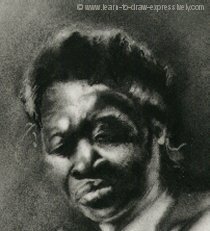
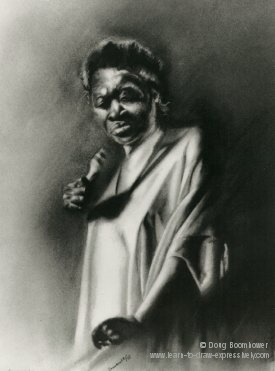
Esther Philips (1935 - 1984)
Jazz/Blues Singer
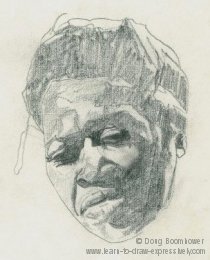
Drawing Hair - The Preliminary Drawing
Here is the pencil preliminary drawing I did of Esther Philips' face.
Notice the subtle loose strands of hair on the left side of the drawing. This pencil composition serves as my guide for the final drawing... it tells me where to put my darks and lights.
I have implied the general shape of the hair. Notice the area I've left white, along the top of her hair, and another light area above her ear.
How to Draw Hair - The Final Charcoal Drawing
The body of her hair is simply a darkened area, which was done with a 3B charcoal pencil and brushes. (No indication of individual hairs in this area.)
The back-lighting is what gives shape to her hair. This was done with a kneaded eraser and white chalk.
The broad light areas on the top of her head, the left side of the drawing (her right temple), and above her ear, were all done using white chalk and a kneaded eraser.
Close observation will reveal subtle white chalk lines on the top of the head, and above her right temple. (This is as close as I get to suggesting individual hairs in these areas.)
The only other areas where individual hairs are suggested, are the white wisps of hair on the right side of her head and behind her ear. These were done to add interest.

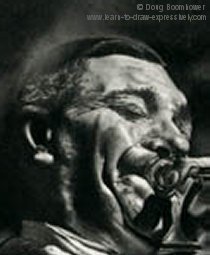
Jack Teagarden, (1905 - 1964)
Trombone player-vocalist
How to Draw Hair, continued
First I laid down the general shape of the hair with a 3B charcoal pencil. At this point, I was only concerned with the general shape. There was no implication of individual hairs.
I used a kneaded eraser and white chalk to indicate a slight wave at the front of his hair. Then I used short strokes of white chalk to indicate individual hairs in the temple area above his ear. This implied hair typical of a man his age.
The sharp contrast across the forehead, implies the shadow cast from above by the wave in his hair.
For the sake of explanation, parts of the images on the left have been enlarged and displayed on the right (see below).
Notice that all three musicians have wavy hair. The top of each wave in the hair will catch the light. The patterns of highlights on each musician's head clearly imply the waves of their hair. Dark areas between these highlights were done with a 3B charcoal pencil.
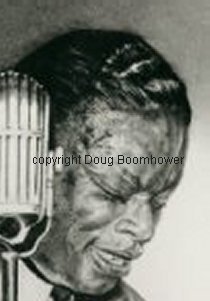
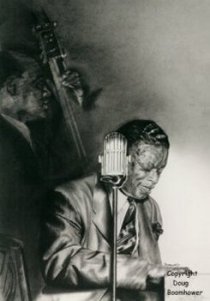
Nat "King" Cole (1919-1965)
Jazz singer-pianist
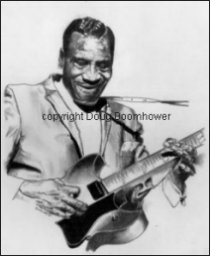
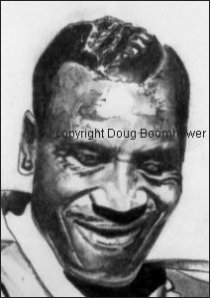
T-Bone Walker, (1910 - 1975)
Blues singer-guitarist
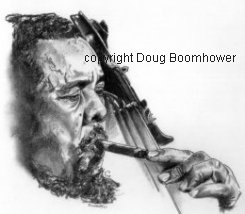
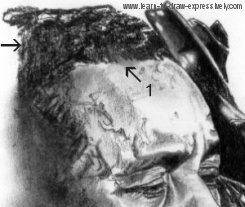
Charlie Mingus, (1922-1979)
Jazz bassist, composer.
Charlie Mingus: Arrow #1: A few strokes along the hairline imply the backward sweep of the hair.
The other arrow (on the left) points out an area where I allow the tooth of the paper to show through....this implies the texture of curly hair. Using a 3B charcoal pencil, I vary the pressure with which I apply the charcoal. The tooth of the paper will show through in the areas where I apply less pressure.
If you liked this page on "How to Draw Hair", see my Site Map for other techniques OR .....
To search my site, enter your search term in the box below, and click on the Search button. (Google ads may appear at the top of the results page ... your search results will be just below.)




